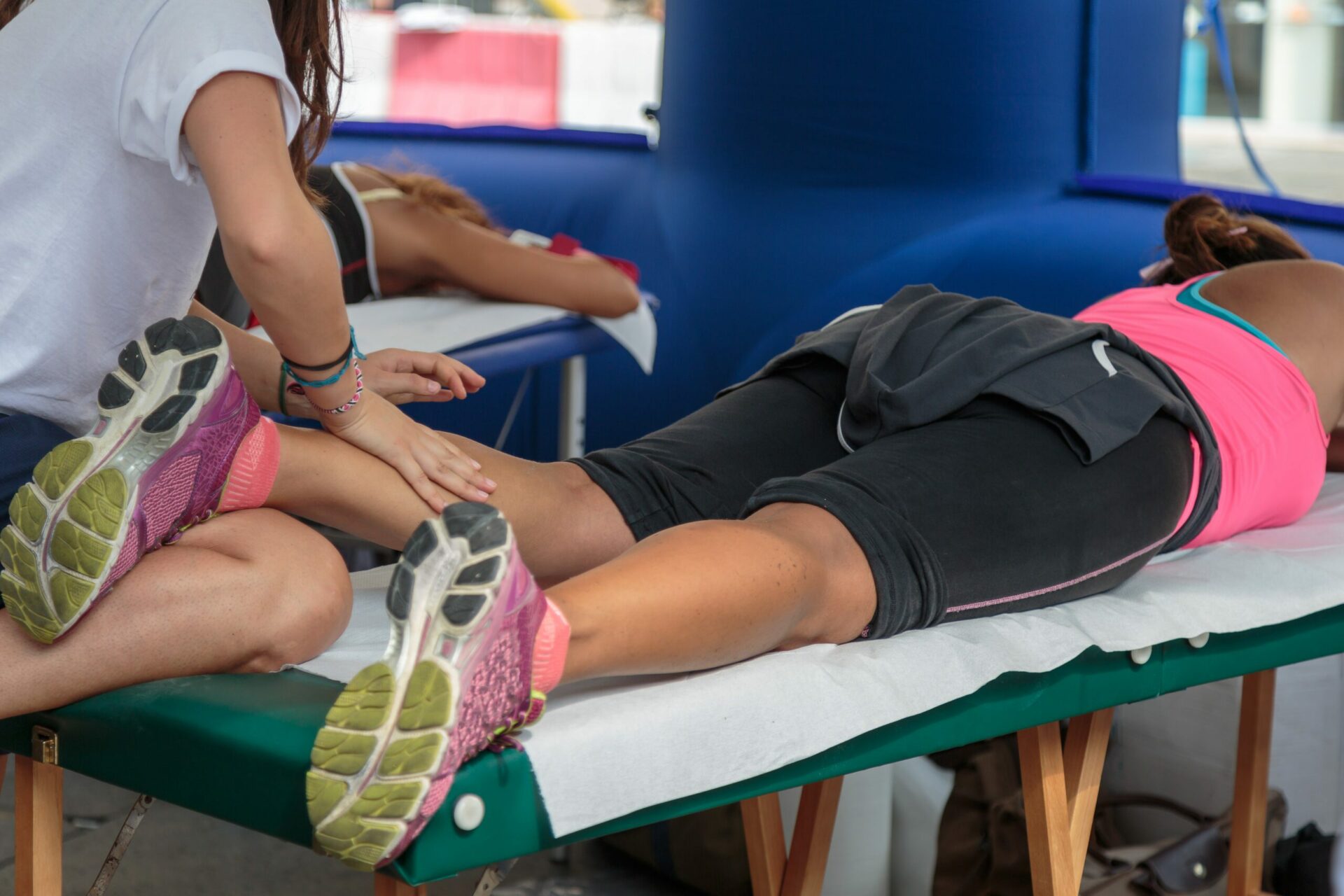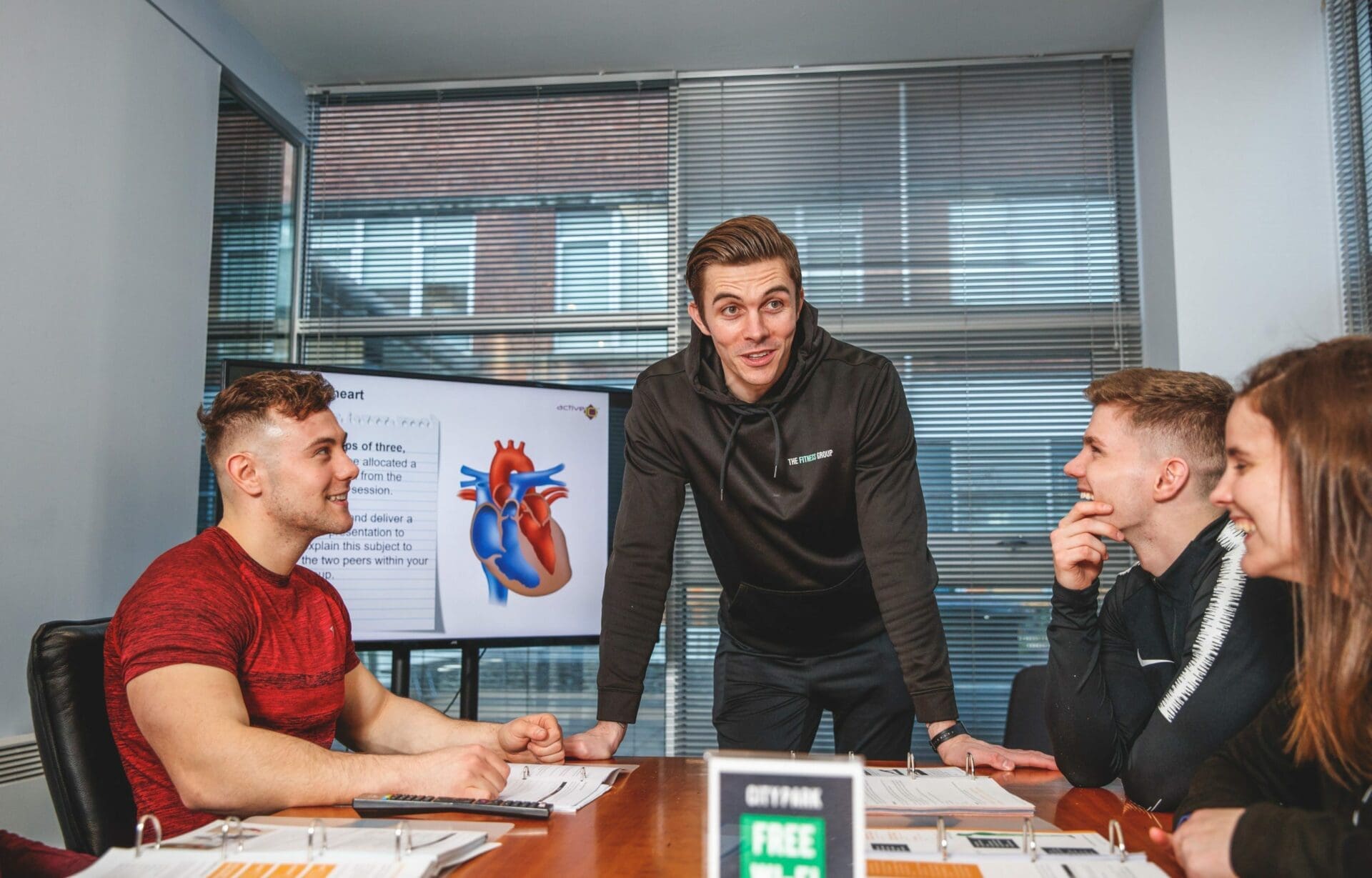How to Become a
Sports Massage Therapist (UK)










How to Become a Sports Massage Therapist
Confused about where to begin on your sports massage therapy journey and how to become a sports massage therapist?
You’re in the right place!
Below you will find the ultimate, step-by-step guide on the process of becoming a sports massage therapist from start to finish.
Our industry experts from The Fitness Group Team will even provide you with vital advice and guidance at each stage of the process, so you can not only get your sports massage training qualification, but you can also secure a long, rewarding career in the sports massage field. Keep reading to begin your journey.

Step 1: Find Out What Being A Sports Massage Therapist Involves
What Sports Massage Therapists Do
Sports massage therapists (SMTs) offer physical therapy that is focused on specific muscle groups. The purpose of sports massage therapy is to help your client with issues such as inflammation, injuries, and muscle soreness. By providing sports massage therapy you will also be able to reduce your client’s risk of further injuries.
Typical duties that a sports massage therapist will complete in their work include different massage types both before and after a sports event or game. The purpose of which will be to help boost performance, minimise the risk of injury and speed the healing process once the game is done.
As a sports massage therapist, you may also be called on to provide emergency help during a sports event, such as on-the-spot massage, and the application of sports tape. You will also have a key role in creating and facilitating rehabilitation programs for your injured clients.

What You Can Expect From A Sports Massage Therapy Career
There is so much you can expect from a career in Sports massage therapy including working closely with athletes, and sports people, and providing them with help and relief when they are in need.
Salary for sports massage therapists is on the higher side too, with Payscale.com showing between £19k – £80k per year. Although it is worth noting that the hourly rate you can ask will differ depending on the type of service you provide with deep tissue massage being the highest at an average of £26 per hour.
One of the best things about being a sports massage therapist is that it’s a very varied job, which means no two days are the same, and there is always something known to leggings.
When it comes to working hours 9-5 may be possible, but because you will likely be needed before and after games, as well as when it’s most convenient for your clients, evening and weekend work is likely.

The Skills & Qualities You Need To Be A Successful Sports Massage Therapist
Many people focus on the sports and biology side of things when they consider whether they want to embark on a career in sports massage therapy. However, while it is true that these aspects are crucial it’s also important to remember that success in this field also depends on being able to effectively communicate, and interact with your clients.
This is because sports massages can be an intense process, and you will need to be able to gain the trust of your clients for you to work together. Indeed, such interpersonal skills including empathy, active listening, and discretion are vital ones that anyone planning on working as a sports massage therapist must develop.
In addition to interpersonal skills, to be successful as a freelance sports massage therapist you will need a good business head on your shoulders. This is because you will need to be able to manage your accounts, attract new customers, as well as expand your business.

Step 2: Earn your Sports Massage Therapist Qualification
To qualify for professional insurance, as well as build up your reputation as a sports massage therapist, you will need to get an accredited Sports Massage qualification.
One of the easiest ways to do this is to start with an internationally recognised level 3 SMT course like this one, which allows you to practice both in and outside of the UK. Despite it being a Level 3 Diploma, the Level 3 Sports Massage Therapy Diploma courses is entry-level course which means you don’t need any previous experience before enrolling.
In your search for how to become a sports massage therapist, we recommend that your first step will be to complete this course.
Our Level 3 SMT course is Ofqual approved and awarded by Active IQ. What this means is you can be sure your training will meet national standards, and that you will be provided with the highest level of training and knowledge as you work through your course.
We also have both part-time and full-time courses which means you can easily fit in your SMT training around your current responsibilities, and progress your career at your own pace.

Step 3: Decide What Type Of Sports Massage Therapist Job You Want
Once you have completed our Sports Massage Course it’s time to think about the type of sports massage therapy job you would like. There are several different routes to choose from as well, including contracted work, and freelance work.
Contracted Sports Massage Work
If you are looking for fixed hours and a fixed salary while working as aSports Massage Therapist, then a contracted position is the best option. In a contracted position you will work for an employer that will pay you a salary. You will not be able to choose your clients as these will be assigned to you by your employer, but you will have more security, especially if you are just starting in the field, as you will be paid a guaranteed wage.
Several different types of employers offer sports massage jobs; including:
- Gyms
- Health spas
- Sports and athletic clubs
- Physiotherapy clinics.
Each different type of business will offer a different working environment, so it’s a good idea to do some research about the type of employer that would suit you best before you apply.
Another bonus concerning working in a contracted role is that you will be able to benefit from learning about the structure and process of the business without taking the risk of going out on your own.
You’ll be able to benefit from the mentorship of more experienced sports therapists around you as well which can set you up with a very solid foundation for the rest of your career.

Freelance / Self-employed Sports Massage Therapy Work
On the other hand, there is a range of benefits associated with working freelance, otherwise known as being self-employed as a therapist. One of the most appealing of these is that you get to choose your hours and rates of pay.
This means as you progress and build up your reputation you can increase the price that you charge your clients. Indeed, those earning at the top end of the pay scale mentioned above tend to be freelancers.
Another advantage of choosing the freelance SMT route is that you will be running your own business. This can work well for people that like to be in control and have an entrepreneurial flair. Indeed, over time if your business is successful you will be able to scale, expand, and grow, perhaps serving additional areas and taking on more employees to help you serve your customers.
However, it is worth noting that there are some additional responsibilities you will need to deal with as a freelancer. In particular, you will need to find a suitable space that you can work out of such as a clinic, gym, or fitness studio.

Step 4: Get A Membership To An SMT Professional Body
After deciding what kind of Sports Massage Therapist role is right for you, you will need to secure your membership in a professional body. This is vitally important because by being a member of a professional body you will demonstrate to your clients that you have the necessary qualifications, certificates, and credibility to serve them properly.
Additionally, being part of a professional Sports Massage Therapy body will also give you access to some excellent career support and advice, which can help you grow your career as an SMT.
There are many professional bodies that you may wish to join as an SMT. These include:

Industry Leading Qualifications
Become a sports massage therapist with our leading Level 3 and Level 4 Sports Massage Courses.
Step 5: Get Your Sports Massage Therapy License
The next stage in the process of becoming an SMT is to get your license. Under the London Local Authorities Act 1991 SMT is classed as a special treatment. You must have a license to practice SMT, along with any other kind of special treatment such as chiropody, manicure, light treatments, etc.
To apply for a license you can visit the relevant government pages here, or contact your local council. If you practice massages or special treatments without a license you could face fines.
If you decided in Step 3 that you wanted to follow the self employed route and start your own sports massage business then you should also register with HMRC.
This will cover both your taxes and your NI contributions which you will need to continue to pay while self-employed.

Step 7. Get Sports Massage Therapist Business Insurance
Another very important aspect of becoming a sports massage therapist is to make sure you have the correct insurance.
Indeed, without the right cover, you can leave yourself and your business or employer open to a great deal of unnecessary legal and costly risk. You could even face prison time if you do not have the correct insurance while seeing clients!
Professional Indemnity Insurance
The first type of insurance you will need as a working SMT is professional indemnity insurance. Primarily this type of insurance covers you and your business if you make a mistake while working.
Public Liability Insurance
The other type of insurance you will need is public liability insurance, which will cover you against accidents against a third party. This type of insurance should cover damage to property, injury, and even death.

Step 7: Learn how to promote your Sports Massage business
If you plan on taking the SMT freelancing route, you will also need to become adept at promoting your business and securing clients. Indeed, the best approach is to develop a sales funnel that will consistently direct customers to your business.
An example of the way you may like to establish your funnel is:
- To start with either PPC, Google ads, or targeted content. To do this you will need to make sure you have a clear idea of your target audience, as well as the services they are looking for and the online platforms that they use.
- From there you can direct potential clients to your SMT website landing page. Including a special or limited offer or freebie info in the form of an ebook, pdf, or video can help establish expertise and build trust here.
- Next comes getting clients to sign up for SMT, you might like to do this online with the help of a chatbot or prefer to get them into your clinic and offer a free consultation.
- Once they have signed up and received treatment you must do everything you can to encourage happy customers to leave feedback. This is because this feedback will make sure that the other potential customer is reassured when considering using your services.
Additionally, it’s a good idea to use a scheme where you offer money off referrals, as this can help clients encourage their family and friends to use your services in the future.

Step 8: Advance Your Sports Massage Career
Finally, to enjoy long-term success as a Sports Massage Therapist you can continue your education and receive further qualifications.
One option you may like to consider is completing a Level 4 Sports Massage Certificate, which will cover more advanced techniques including symptom recognition, and higher-level massage.
In addition to your sports massage certifications, you might wish to expand your portfolio and brand by offering extra services to your clients.
For example, many SMTs also hold a Personal Training Qualification, so they can create personalised workouts for their clients that are mindful of their specific injury and recovery needs.
A Nutrition for Sport and Exercise Performance course can also be a great match for an SMT. This is because it allows them to offer a greater range of useful services to their clients, ensuring that they are not only getting the massage they need for peak performance but the nutrition as well.

How to Become a Sports Massage Therapist | Summary
The path to becoming a sports massage therapist may seem complicated in the beginning, however, by breaking down the process into the easy-to-follow steps above you can look forward to a long and successful career in an area where you will make a significant difference in people’s lives.

Book Call with our Career Support Team
FAQs
Active IQ is the leading awarding organisation in the industry and their qualification standards are renowned as being the leading standard. Active IQ are recognised and regulated by Ofqual within the Active Leisure sector. The certifications they provide act as a benchmark for quality and credibility for those wishing to join the industry.
We use Active IQ as our chosen Awarding Body as we want to ensure our students achieve an renowned internationally recognised qualification that is fully recognised in the industry by all employers.The Fitness Group Education has consistently achieved the highest possible Education Centre Quality Approval Rating every year in all internal and external quality audits.We provide the highest standard in health and fitness education.You can sign up and start studying straight away by booking onto your course on our website. Simply select your course page and then follow then options to book onto your preferred method of study. You can then choose to pay immediately or with one of our payment plans. If you choose a payment plan there will be no payment taken at sign up.
If you would like to chat to us first though then we would love to hear from you, you can contact us by filling in a contact form on our website, you can chat to us on Live Chat on our website, directly by email or by phone.
We can arrange a call or an appointment at a time that suits you, we will spend time with you to answer any questions you may have on our course options.
Yes you can pay your course in 1 single payment, we accept all payment methods. We have an immediate payment offer on all courses. Additionally, we have now introduced Klarna and Paypal Finance to our payment options. You can use both options and split the cost with no fees.
We offer all our students the opportunity to pay for their chosen course with manageable, affordable monthly instalments at 0% finance. The finance calculator on our sites provides you the opportunity to tailor your repayment to your terms. You can spread the cost of some of our courses as far as over over 18 months and you incur no extra costs.
If you choose a monthly payment option no immediate payment will be taken on sign up and in some instances depending on what payment date you select the first payment can be delayed as far as 1 month from sign up.If you want to discuss the finance options available further with us then contact us and one of our friendly team members will contact you to discuss your course requirements and payment finance options.
At the moment we have some offers available on our course options, the finance calculator is updated to reflect our new offer prices.
